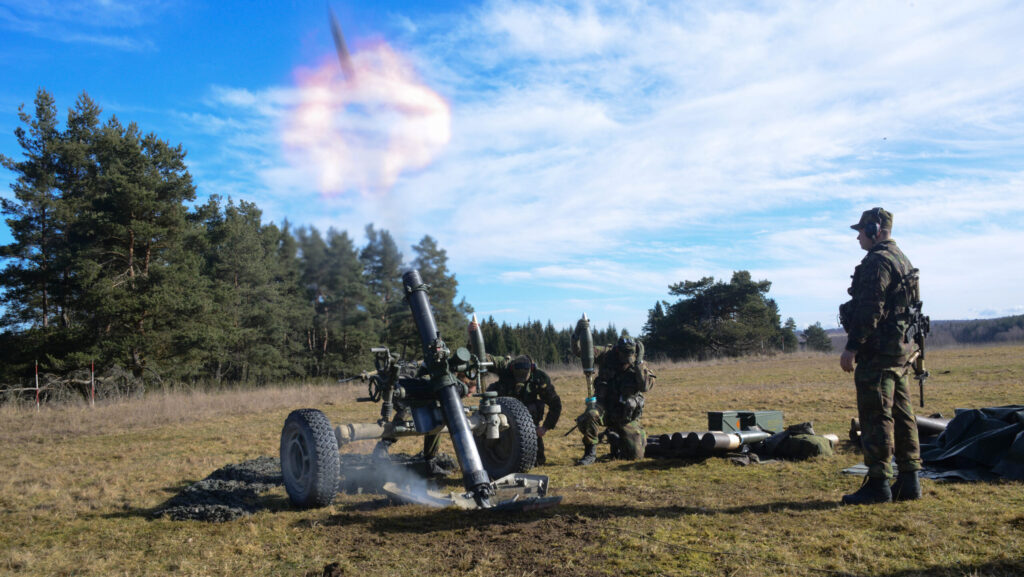
Dutch soldiers fire a 120mm illumination mortar round in preparation for the European Battlegroup Certification, at the Grafenwoehr Training Area in Germany (US Army)
BELFAST — The European Commission (EC) has promised to make the continent’s industrial base more competitive, “tap its full potential” and deliver a level of manufacturing readiness capable of withstanding Russian aggression.
That’s according to the commission’s first ever Defence Industrial Strategy rolled out today, which includes proposals to break European Union (EU) dependence on US military hardware and establish a new European Defence Industry Programme (EDIP) aimed at boosting weapons production and increasing collaboration between manufacturers.
To support EDIP, the EU would invest €1.5 billion ($1.6 billion USD) on the project between 2025 and 2027.
Such relatively modest funding falls far below a recommendation made in January by Thierry Breton, European Commissioner for the Internal Market, to deliver a special €100 billion ($109 billion) defense projects fund.
The European Commission dictates and oversees EU law, policy and budgeting.
It said in a statement that the Defence Industrial Strategy “sets a clear, long-term vision to achieve defence industrial readiness in the European Union,” though cautioned that increasing readiness requires member states to “invest more, better, together and European.”
The focus on readiness and an urgent need to adapt to Russia’s threat is strongly articulated throughout the full text of the strategy itself.
“Faced with the return of high intensity warfare in Europe, following Russia’s unprovoked, full-scale invasion of Ukraine in 2022, the Union must swiftly enhance its defence readiness,” it notes. “Defence industrial readiness must be strengthened across the Union, paying particular attention to the specific implications that this has for those Member States most exposed to the risk of materialisation of conventional military threats.”
Two of the more lofty targets set out in the document cover EU member states, 27 in all, procuring 40 percent of their defense equipment collectively by 2030 and an effort to “ensure” by the same date that the value of “intra-EU defence trade” represents 35 percent of the overall EU defense market.
The Commission also wants to see “steady progress” on member states spending, at a minimum, 50 percent of their defense budgets on EU procurements. How that seismic transformation happens remains to be seen, especially as Europe relies heavily on US military equipment. As one example, around 56 percent of all new equipment orders by Poland between 2018 and 2022 were given to US companies, according to Polish foreign affairs minister Radosław Sikorski.
More concerningly, 78 percent of EU member state military acquisitions from the start of Russia’s invasion of Ukraine in February 2022 to June 2023 were signed with manufacturers outside Europe, with the US alone accounting for 63 percent of that total, figures from France’s Institute for International and Strategic Affairs (IRIS), a think tank, indicate [PDF].
There are some green shoots of industrial progress for the EU, with its Defence Technological and Industrial Base (EDTIB) increasing ammunition production capacity by 50 percent, since the start of the Ukraine war. In the short term that capacity is forecast to grow, according to the new strategy.
The EDTIB is “already capable of producing one million artillery rounds per year and is anticipated to reach a capacity of over 1.4 million by the end of 2024 and 2 million by the end of 2025,” it adds.
In spite of production adjustments, the EU was forced to admit it would miss a target of delivering 1 million rounds to Ukraine by the end of this month. Rather, it will take until the end of 2024 for that to happen.
The strategy acknowledges that delivering a Europe-wide industrial ramp up depends on an increased “volume of orders” by member states, which can only succeed if national defense budgets are boosted.


